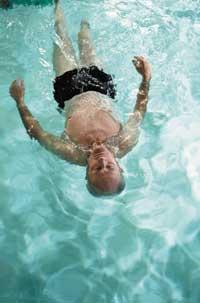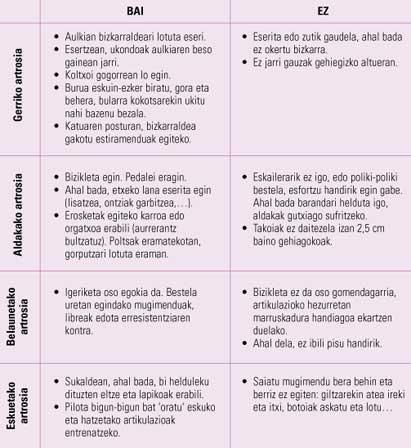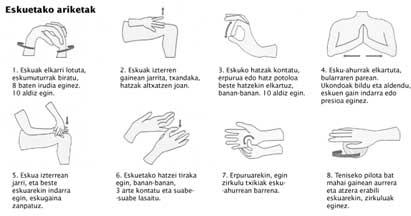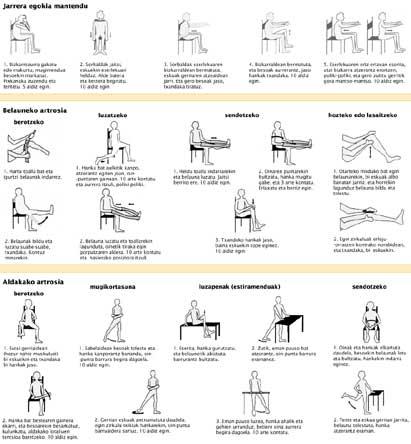To live better with osteoarthritis
Our body would be a fragile puzzle formed by rigid bones if not by joints. Thanks to these joints between the bones is possible movement. And to ensure the normal functioning of the joints, and to avoid the deterioration of the bones when they rub each other, there are cartilages, such as cushions or shock absorbers between the bones.

It is normal for time (and movements in daily life) to deteriorate and erode joints and cartilage. And in cases where this degenerative process is continuous, the cushion between the bones is disappearing and the bones collide directly with the other, without the cushion softening the blow: this is where the osteoarthritis begins and gradually the symptoms appear (joint pain, inflammation, stiffness, deformity and difficulty to move) and sometimes also the spark or the crispy sounds.
This chronic disease can appear in any joint of the body, but it usually appears in those that are most used or bear more weight, such as the joints of the spine, hip, knee and hands. According to Dr. Carlos Ossorio, a member of the Spanish Society of Rheumatology, “between 20 and 40 years the arthrosis affects approximately 4% of the population, while from 70 years the incidence is 80%.” What does this mean? The older the person is, the higher the risk of osteoarthritis, but not all older people have to have osteoarthritis, since they do not know why the disease occurs.
Factors of appearance of osteoarthritis
If the weight affects the joints until their deterioration, it is logical to think that very obese people have a higher risk of suffering an osteoarthritis, since their bones must endure a constant overweight. If that is your case, reader, remove the excess kilos. Your back and your joints will thank you.

Not all, of course. For example, those who use pneumatic hammers (and devices that, like this one, generate many vibrations). Or professions that require an excessive use of a certain articulation: hairdressers, tailors, etc.
Only in the arthrosis of the hand, not in the rest of the joints. And as curiosity, the hereditary component is much more evident among men than among women (although 7 out of 10 people with osteoarthritis are women). Children are at higher risk for osteoarthritis and not for developing this disease.
Unfortunately, inadequate postures are adopted from early ages, and remain in maturity. For example, sleeping in an inadequate bed (usually too soft), sleeping prevents the spine from adopting its anatomical posture during sleep.
Excessive or inadequate sports practice and the deterioration of a joint as a result of a previous bone fracture can also facilitate the wear of the cartilage, which in the long run will cause the appearance of osteoarthritis.
Different ways of treatment

Today there is no healing treatment, but that is not enough reason to despair of the disease. Osteoarthritis is not something normal or physiological, something we must endure. And the appearance is not in our hands, but we must get the affected person to have less pain and more mobility.
- It is important to avoid the aforementioned risk factors (obesity, poor postures, etc. ). ) and, at the same time, follow the doctor's instructions: take medicines to relieve the symptom and rehabilitate it properly so as not to lose muscle strength and joint mobility.
- There are new and encouraging treatments that can slow the evolution of the disease: cartilage protectors, injected into the joint, to strengthen local synovial fluid.
- Two types of drugs are used against pain: the most common are analgesics, but if the pain persists or the joint is increased, non-steroidal anti-inflammatory drugs of last generation are used (unlike the previous ones, these do not damage the mucosa of the stomach). If there is no improvement with these drugs, intramuscular infiltrations with corticosteroid derivatives should be performed.
- The last step is surgery. It should be noted that surgery can be very suitable for the control or treatment of osteoarthritis in certain cases. On the one hand, it can be used preventive, for example in the case of genu valgum (that is, with bent legs) to combat the osteoarthritis that may take. Or when pharmacological treatment has not been effective. In these cases, the joint is replaced by a prosthesis.
Importance of the movement
For the joints it is important to perform an exercise not overly charged and discard sedentarism, is a recommendation that the doctor always does and that many times can be easily fulfilled.
Once the pain is diminished (due to the drugs), the patient must understand that it is necessary to walk or swim: in this way, the cartilage of the joint is impregnated with synovial fluids and covers all the necessary nutrients. If the person does not move, the cartilage does not nourish and the degeneration appears faster.
The influence of the diet can be very high, to the point of decreasing the severity of the symptoms of osteoarthritis. Some tips are:
- Eat a lot of fish. Although there is no clear and clear scientific evidence, it seems that the fatty acids of some fish mitigate joint problems. We know how to consume salmon, trout, sardines or anchovies more than once a week.
- Take into account the foods rich in vitamins A, C and E: carrot, apricots, melon, liver, orange, red peppers, tomato, brussels sprouts, cabbage, nuts, olive oil…
- Take care of the weight. Therefore, discard flours or derivatives (bread, buns or cakes); sugars and sweets; chocolate; bacon, butter or sausages; sauces; products in brine and alcohol. And instead it consumes fruit, vegetables, skimmed milk, whole grains, fish and meat muscle.
- Consume cooked, roasted or steamed and never fried.

Physical exercise performed with moderation and following treatments prescribed by the doctor or physiotherapist, maintaining in each situation the correct posture or posture of the joints. These are the best ways to delay the deformation and degeneration process.







